Encouraging ranging behaviour
Understanding behaviour
The section is divided into a series of sub-sections covering a number of important behavioural topics that influence positive welfare. It is recommended that all of these sub-sections are read as the promotion of positive welfare requires a broad understanding of bird behaviour.
Natural behaviour
The promotion of naturalness and the provision of a natural environment that enable birds to conduct basic natural behaviour is a fundamental principle of positive animal health and welfare.
The exhibition of natural behaviour can be an asset to production, as well as a positive welfare indicator. For example, ranging activity may be required for effective utilisation of crop residues, integration with cropping activities (e.g. using poultry as a means of weed control in horticulture) and soil fertility building (e.g. spreading manure). However, there are also associated risks, including parasite infestations, losses through predation and exposure to climatic extremes. A basic understanding of natural behaviour would appear to be essential in ensuring the maximum benefit and minimising the risks involved in free-range management.
One means of understanding the natural behaviour of domestic animals is to study their wild counterparts and ancestors. Many of the breeds of poultry currently used in commercial poultry farming have been specifically selected for intensive systems of production which, in many respects, provide living conditions very different from those found in natural habitats. Behaviours that use a lot of energy, such as foraging and social interaction, tend to be less frequent in modern commercial breeds compared with the red jungle fowl and some of the more traditional poultry breeds, with conserved energy being utilized for production purposes (Lund and Weary, 2004 in Vaarst et al., 2004).
Nicol and Dawkins (1990) claim that there is no evidence to show that genetic selection for egg laying has eliminated a bird’s potential to perform a wide variety of behaviour. In an experiment where battery reared hens were given a choice between an outside run and a battery cage, the birds initially preferred the familiar environment of the cage. However, a few minutes experience in an outside run was enough to persuade them that they preferred the run (Dawkins, 1980). See also Breeds.
Group size
The main affiliative behaviour shown by poultry is flocking (Appleby et al., 1992), an activity which is considered to have evolved primarily as protection against predators. Birds in large areas normally stay together in a group. Group size and the ability to perform natural behaviour are important welfare considerations.
Domestic fowl (Gallus gallus domesticus) naturally live in small groups, with a dominance hierarchy or pecking order most likely based on establishment fights, followed by remembered assessment of status involving individual recognition. In larger groups, this system is thought to break-down, and hens may adapt by becoming less aggressive, or by restricting their movements to defined ‘territories’ (D’Eath and Keeling, 2003). Hens in small groups, but not large groups, have been shown to discriminate between familiar and unfamiliar subjects by showing more aggression towards unfamiliar hens.
Social dominance or “pecking order” in poultry has been described in small groups of hens in Norway (Schjelderup-Ebbe, 1922, cited by Appleby et al., 1992). Within flocks there are birds of high rank able to peck or displace others and those of low rank who will be displaced by others in the flock. In small, stable flocks, this hierarchy should not result in excessive aggression unless other factors, such as feeding space, encourage it. The relative “rank” of a bird in a flock is reflected in posture and movement (Wood-Gush, 1971).
Individual recognition of other hens seems to be limited to groups of up to 80 birds, and, in general, small group size is desirable if natural grouping behaviour is to be encouraged. Dawkins (1980) notes that “preferred” group size is not constant but depends upon how familiar the birds are with each other and how familiar the surroundings are. In large flocks, sub-flocks may emerge. Birds from large flocks tend to exhibit less aggressive behaviour than those from smaller groups. This may be a consequence of the lack of social structure in large flocks (Hughes et al, 1997).
In large groups hens become less aggressive and may change their social system to one where dominance is determined through direct assessment and ‘status signalling’ rather than the remembered individual assessment of a small group pecking order (D’Eath and Keeling, 2003).
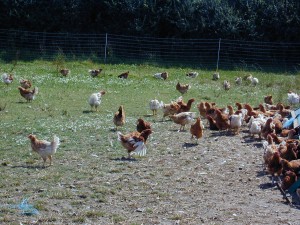
The spacing of birds within a flock varies according to the activities they are undertaking. They roost and preen close together, and spread out more during foraging and ranging. This latter activity may just be the requirement for “personal space” (Appleby, Hughes and Elson, 1992)
Under natural conditions each small group of fowls has a regular roost and an area in which it usually forages (Nicol and Dawkins, 1990). Similar behaviour is observed in small backyard systems.
Wide open fields are not preferred habitats for chickens. They prefer ranging areas with trees, they avoid bright sun and they tend to stay close to the house or seek tree cover (Dawkins et al., 2003). The forests where their ancestors the junglefowl occur, frequently consist of thick clumps of bamboo separated by small clearings, so that the birds can see the approach and seek cover from predators.
The main activities of free-range hens are grazing, ground pecking, ground scratching and dust-bathing. The extent of these is weather-dependent (Hughes and Dun, 1983). Semi-wild jungle fowl spend up to 60% of their time actively pecking the ground, even when not hungry, and domesticated free-range birds will spend time pecking for food even when poultry feeds are provided ad lib (Nicol and Dawkins, 1990). Experiments examining social factors influencing feeding and growth have been conducted by Blokhuis and ven der Haas (1992) show that foraging-related behaviour, such as scratching and pecking, is apparently influenced by experiences during rearing. A social structure based on leadership seems characteristic of chicken groups, even those consisting of very young birds (Adret-Hausberger and Cumming, 1987).
Ranging and foraging behaviour
Although scatter-feeding of pelleted feeds or grain may assist in promoting foraging, this can be expensive. Scatter-feeding may also encourage wild birds and predators, along with the associated potential disease and mortality losses.
The behaviour of junglefowl and chickens is known to vary throughout the day (Dawkins, 1989), so range use might be affected by time of day, with mid-morning being one of the least likely times for birds to venture out.
In free-range systems, birds are often seen to gather in flocks close to houses. Keeling et al (1988) examined the ranging behaviour of free-range hens housed in a static polythene house. Some individuals were never observed outside the house, whereas others spent more than 75% of their time on range. Attempts to increase the number of birds on range by varying the number of open pop-holes and changing feeding times were unsuccessful. Only a small percentage ranged any distance from the house.
Bubier and Bradshaw (1998) recommend that ad lib feeding should be given to poultry, as this has the effect of preventing hens from remaining in or near the house in anticipation of feeding time. The number of hens found outside is dependent on weather conditions, and the number that emerge outside after morning opening of pop-holes varies considerably daily (Hughes and Dun, 1983). Placing feeders outside houses encourages birds to spend time outside (Grigor et al., 1995a). Early exposure to outdoor areas encourages birds to spend longer periods outdoors as adults (Grigor et al., 1995b)
Laying hens in larger groups do not use the range as often as those in smaller groups (Hirt et al., in Hordegen and Zeltner, 2000) (see Group Size)
Range enhancement
Trees have a multi-purpose role, providing shelter, shade, dust-bathing areas, protection from ground and aerial predators, provide food and act as a weather break. ‘Verandas’ may provide a tree substitute. Although the provision of trees offers some environmental protection and can encourage birds to range more widely, these may also provide fox cover, thus enhancing the risk from predation. A major consideration with regard to system design is the time taken to establish trees within a range, unless these are already in place. It has been shown that young trees (up to 2 years) do not provide any more welfare benefits than purely pasture based systems (Jones et al., 2007)
Enhancing the outdoor environment with structures such as roofed boxes with sand have been shown to positively influence birds to range further (Zeltner and Hirt, 2003). Conifer wigwams may offer a means for more even use of pasture and better distribution of droppings (Gordon and Forbes, 2002).
Birds should not be maintained on soil types (e.g flinty and stony ground) that may cause excessive damage to feet and legs.
Chickens may be encouraged to go outdoors by brooding in a less “controlled” environment than that used for intensive broilers, and by allowing access to pasture when young. However, mortality tends to be higher.
Ranging behaviour of free-range broilers
There has been less research completed on the ranging behaviour of birds produced for meat than that done on laying flocks. In commercial free-range broiler systems, many birds never leave the houses, suggesting that the environment provided is not the preferred habitat (Dawkins et al., 2003). It has been demonstrated that early access to pasture can increase range usage, and a natural shelter in the form of a conifer wig-wam was attractive to birds and well used (ADAS, 2002). As with layers, tree cover, season and time of day all influence the extent of ranging amongst broiler birds (Dawkins et al., 2003).
Slow growing breeds have been found to spent more time foraging, walking and perching. Fast growing broilers spent more time sitting, drinking and eating (Bokkers and Koene, 2003) (See also Breeds)
Click here for further information on Poultry Behaviour.


 American English
American English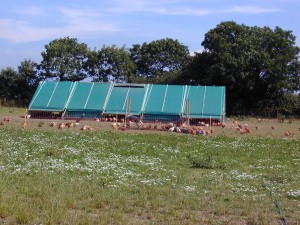
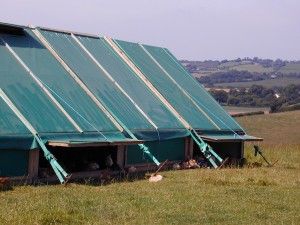
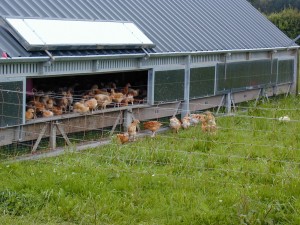
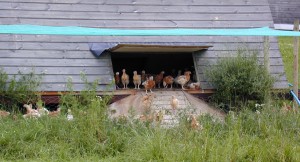
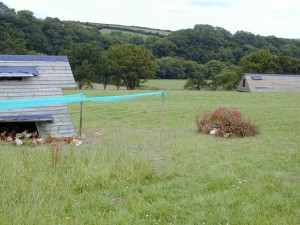
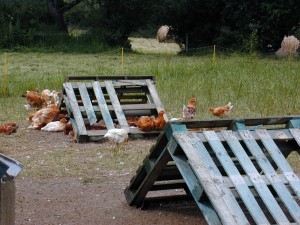


Comments are closed.